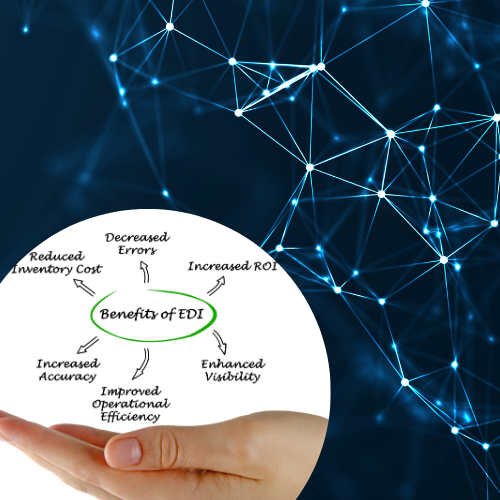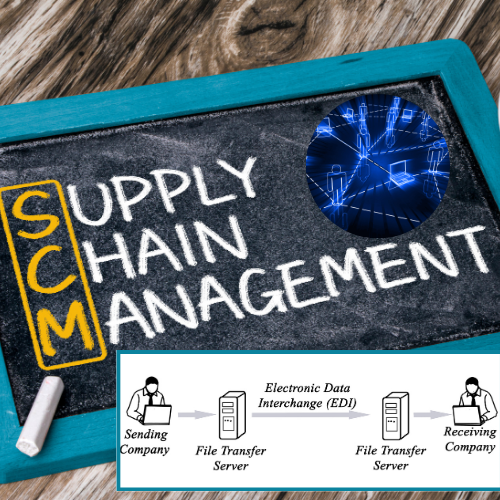How Electronic Data Interchange (EDI) Streamlines Your Day!
- FEWER ERRORS: By replacing manual, paper�based processes with automated ones, you can significantly reduce or even eliminate human errors. EDI gives you and your trading partners a clear view of the entire order and invoice process. This complete visibility helps you make better decisions and ultimately improves the services to the end customer
- ENHANCED VISIBILITY: EDI gives you and your trading partners a clear view of the entire order and invoice process. This complete visibility helps you make better decisions and
ultimately improves the service to the end customer
- REDUCED INVENTORY COST: Increased visibility within the supply chain removes uncertainties and allows you to lower the amount of onhand inventory
- INCREASED ACCURACY: Automated message validation helps you catch and fix errors before they affect your trading partners and ensures that your internal systems have reliable data
- IMPROVED OPERATIONAL EFFICIENCY: You can streamline your operations and save time by using integrated EDI to automate the exchange of messages and avoid entering data manually in different systems
SIGN UP NOW!
 What is Electronic Data Interchange Used for?
What is Electronic Data Interchange Used for?
EDI uses standardized formats to exchanged documents securely between businesses. There are several ways in which EDI documents can be transferred: direct EDI, value-added networks, also known as VANs and web-based EDI. With EDI, communication is allowed between different computer systems which enables each party to continue to use their own internal systems without inhibiting the success of EDI documents being transferred.
What are the Types of EDI Documents?
- 810 Invoice - Invoice is sent by a seller to a buyer, to indicate the charges due, and request payment according to agreed-upon terms
- 820 Payment Order /Remittance Advice - Confirm payment details and/or advise the seller of any adjustments to the payment amount
- 850 Purchase Order – Electronic purchase order sent to a vendor as the first step in the ordering process
- 852 Product Activity Data - used primarily to share data related to inventory positions and movements, such as sales and restocking, between suppliers and distributors
- 855 Purchase Order Acknowledgement - sent by a seller to a buyer in response to an EDI 850 Purchase Order
- 860 Purchase Order Change Request - sent from a buyer to a seller when the buyer needs to make changes to their EDI 850 Purchase Order
- 856 Advance Shipping Notice (ASN) - used to advise the receiving party of a shipment
- EDI 863 Report of Test Results- Transmits the results of tests performed to satisfy a specified product or process requirement
- 997 Functional Acknowledgement - used by trading partners to confirm the receipt of other EDI documents
- 753 Request for Routing – sent from supplier to buyer and is used in situations where the buyer, rather than the supplier, is controlling their inbound transportation process
Understanding Common EDI Terms:
- Trading partner - the sender or receiver of edi business documents
- Transmission - set of edi business documents sent by or received from a given trading partner
- Transaction set - an edi business document (invoices, purchase orders, functional aknowledgments, etc.)
- Van (value added network) - a van is an independent company that provides a storage and forwarding service for edi transmissions between trading partners
- Ansi x12 standard - implemented by the american national standards institute (ansi) to define edi business documents. This is the standard for most, frequently used by u.s. companies
- Edifact standard - a united nations’ committee sanctioned this standard to define edi business documents. Many expect this to become the world-wide standard for edi transmissions
- Translation software - this translates edi documents to a flat file that can be used by application software or to a user[1]friendly format
- Mapping requirements - the requirements of a customer’s transaction set. Identifies fields for a transaction set so that the computers understand where each field should be placed on that document
- Production - sending live data through the edi network
- EC - electronic commerce
- FTP (file transfer protocol) – used to transfer data from one computer to another over the internet, or through a network. Ftp is a commonly used protocol for exchanging files over any TCP/IP based network to manipulate files on another computer on that network regardless of which operating systems are involved
2/12/2025 5:42:25 AM

 What is Electronic Data Interchange Used for?
What is Electronic Data Interchange Used for?